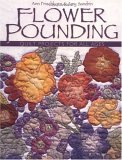
Flower Pounding: Quilt Projects for All Ages

The Art and Craft of Pounding Flowers
If you pound flowers or leaves onto cloth with a hammer, you can make a lovely image with the natural pigment.
Is this dyeing? No.
The majority of natural pigments do not make suitable dyes. They may fade when exposed to light; they may change color upon being exposed to the air by the action of the pounding - and most of them will certainly wash out, if you ever make the mistake of washing your creation. Heat setting might increase the lifespan of your work in air, but it will not make it washable.
The colors from flowers that have been pounded onto fabric are no more washable than paintings made with watercolors on paper!
Alternatively, you can scan your images and use the product Bubble Jet Set to make printable fabric that you can print onto directly with your computer printer. (See Caryl Bryer Fallert's Bubble Jet Set FAQ; she also sells Bubble Jet Set, as do Dharma Trading Company and other suppliers.)
The other good way to make permanent designs with your pounded flowers is to carefully paint right over them, using any good fabric paint or fabric marker. This method allows people who can't draw to produce very pretty paintings.
Fabric paints. Recommended fabric paints include Jacquard Textile Colors, Setacolor, Lumiere, Neopaque, and Versatex Fabric paint; these paints affect the feel of the fabric less than cheaper paints, and give superior results. If you cannot find these fabric paints locally, check out sites such as Dharma Trading Company, whose contact information is given on my Sources for Dyeing Supplies page. Be sure to read about fabric paints first: see Fabric Paints: a different way to color fibers.
Dyes. If you are familiar with the use of dyes, fiber reactive dye, such as Procion MX dye, can also be used to paint over your flowers with a fine brush, especially if you use a thickener such as alginate.
Fabric markers. Fabric markers may be the easiest to use. Do NOT use ordinary permanent markers that are not manufactured specifically for use on cloth. Buy only those markers labeled as being permanent on fabric! Fabric markers will last through many washings, as long as you do not use bleach (it also helps to always turn garments inside out before washing, to reduce wear). I have had excellent results that lasted for years, with Marvy brand fabric markers, and have also had good results with Identipen fabric markers, among others;. You must read and carefully follow the manufacturer's instructions about heat-setting or drying times! As a general rule, it is best to allow markers and fabric paints to dry for two weeks or more before washing them for the very first time.
 see answers to other FAQs about dyes and dyeing
see answers to other FAQs about dyes and dyeingAll of the pages on this site are copyright ©1998‑2026 Paula E. Burch, Ph.D.
This page was last updated: August 11, 2008
This page was first created: April 13, 2003
Downloaded: Sunday, January 04, 2026